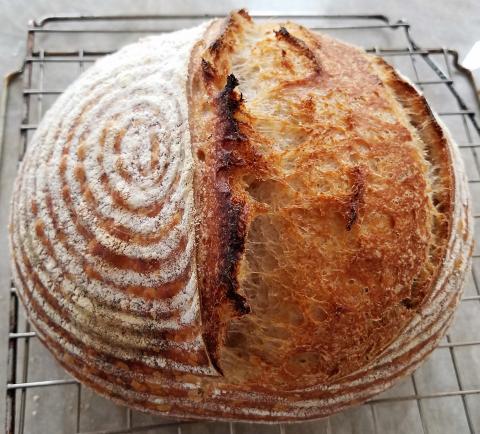The copycat is back, that would be me. David Snyder's recent post on his work in progress, Semolina Capriccioso, had my brain already plotting a visit to this bread, especially as he described the taste. I've already professed my adoration for his Sourdough Italian Baguette bread a few times on TFL. So the wheels encased inside my cranium were turning and I just had to scratch that itch. Y'all know what I mean!
I was interested in making a trip down to North Miami Beach (hint - don't go there expecting a beach, the name is a misnomer) to the only really real Italian market that I know of in these parts - Lorenzo's. And here is what I saw. Ian and other pizza aficionados - I'm talking to you! 5kg bags of 00 pizza flour for US$15.

But that wasn't what I went for. No, I came home with this:

Lorenzo's has shelves of semolina and semolina rimacinata. Those plastic containers are full of semolina rimacinata too, but at US$1 per pound. I didn't see them until I was just about at the checkout counter. Boy what a haul! (not to mention the goat butter too)
So off to the task I went. I used my 50% hydration rye starter for the 50% hydration durum biga in the late morning, and by evening saw no signs of life. So I started a second biga using my ever-ready 75% hydration levain, fed it down to 50% and built the biga for an overnight ferment. By early morning it had doubled, as David suggested it should, and so I used that and discarded the rye starter version. Here are the two bigas at daybreak Easter Sunday:

I reformulated the original formula weight for 50% more than David's and came up with about 1565g for a mix. Wanting to try my hand at my French Folds at this 80% hydration dough and to not rely on my mixer, I was successful, but added another 100 FFs because the dough was so slack and David wrote that his mixer was whirring for ~12 minutes. Still, the dough was completely workable by hand, no mixer was employed and it was billowy with some tension . And this is what the dough looked like after the 400th FF:

I didn't want to interrupt the development of the gluten during the mixing phase, so I added the toasted sesame seeds during the first of the five Letter Folds. And this is what it looked like just as it was to be retarded.

I figured on 2 600g batards and one ~340g baguette. The dough was indeed a bit slack and the rolling of the baguette certainly attested to that. But although the batards were equally slack, they were much easier to form and did not present any problems at all.
At bake time I apparently made the 2 middle scores on the baguette too close together again and the oven spring just blew right past them. Still need more work on perfecting the double score on batards as these were a little bit too offset in parity. I think that the shorter scores on this type of dough as a baguette are more iffy than on the batards because the dough is so wet and the seeds also help weigh down the shorter scored flap during oven spring.
The baguette baked for 27 minutes, the batards for 30 minutes plus a 6 minute oven venting, oven off.
Changes from David's O.P.:
- Used bread flour instead of AP flour.
- Mixed by hand - 400 French Folds (they go fast! Faster than the time that the dough was in David's mixer.)
- Incorporated the sesame seeds on the first Letter Fold. More than I imagined once I saw them spread out across the dough.
- Kitchen at ~80dF, therefore 5 Letter Folds at 25 minute intervals.
- Retarded for approx. 10 hours prior to divide and shaping As I've stated before, the number of hours between retard and shaping is virtually irrelevant.
- After divide, and shaping they went on a couche and back into the retarder for an overnight nap.
- The batards were robust enough to stand up to rolling them on a wet paper towel and then in a plate full of sesame seeds.
Baked straight out of the refrigerator, no warmup. Here the steam had just been released.





The taste is lovely!
April 2 update: I re-formulated to exchange the 50% hydration semolina biga with my own 75% standard levain. I also adjusted the final dough amount of flour and water to abide by the 60% durum flour in the mix and also to maintain the 80% hydration level. As I didn't perceive any benefit to the sesame seeds inside the braed, so I also eliminated that as well.
For a first run, I kept the total dough weight down to 2x500g batards. More experimentation with larger batards will soon be underway. And then I can write up a little more about it. Just one picture from this run should demonstrate that the results are about the same, and the bread is just as delicious.

alan

















